Xianyang Facts
Chinese Name: 咸阳 (xián yáng)
Population: 4,356,200
Area: 13,134 square kilometers (5,071 square miles)
Location: in the east-central of Shaanxi Province, northwest China
Administrative Division: 2 districts (Qindu, Weicheng); 9 counties (Sanyuan, Jingyang, Qianxian, Liquan, Yongshou, Changwu, Xunyi, Chunhua, Wugong); 2 county-level cities (Xingping, Chenzhou)
Area Code: 029
Zip Code: 712000
GDP (2019): CNY 219.533 billion (USD 31.821 billion)
Once Capital of the Qin Dynasty with Mausoleums of Han and Tang Dynasties
Located in the central part of Shaanxi Province, Xianyang is about 30 kilometers (19 miles) northwest of Xi'an with the Weihe River immediately to the south. The charm of Xianyang always relies on its long history and numerous historical sites. Qin Dynasty (221 BC – 207 BC), the first feudal dynasty in China, was born here. What’s more, there are 28 mausoleums of emperors of the Han and Tang dynasties. Qian Mausoleum and Zhaoling Mausoleum are the most well-known and the former one is famed for burying the couple emperors of the Tang Dynasty. In addition, Yuanjia Village, which is only 30 minutes to 1 hour’s drive from Xianyang and Xi’an shows the local folk culture and spreads various characteristic handicraft workshops.
 Pictures
Pictures
Xianyang Attractions - Things to Do
 Qian Mausoleum: The mausoleum contains the reposed Emperor Gao Zong of Tang Dynasty (618-907) and his Empress Wu Zetian, the only female monarch in Chinese history. The mausoleum is built against the backdrop of Liangshan Hill, and the tomb design replicates the ancient Chang'an city.
Qian Mausoleum: The mausoleum contains the reposed Emperor Gao Zong of Tang Dynasty (618-907) and his Empress Wu Zetian, the only female monarch in Chinese history. The mausoleum is built against the backdrop of Liangshan Hill, and the tomb design replicates the ancient Chang'an city.
 Great Buddha Temple (Da Fo Si): 10 kilometers west of Binxian County, this Buddhist site has stood for over 1,300 years. A total of 130 grottoes on the 400-meter-long rock surface store thousands of Buddha statues of all sizes. Within the temple, the 20-meter-tall Buddha is the most spectacular one.
Great Buddha Temple (Da Fo Si): 10 kilometers west of Binxian County, this Buddhist site has stood for over 1,300 years. A total of 130 grottoes on the 400-meter-long rock surface store thousands of Buddha statues of all sizes. Within the temple, the 20-meter-tall Buddha is the most spectacular one.
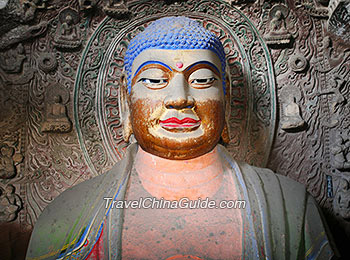 | | Great Buddha Temple | | 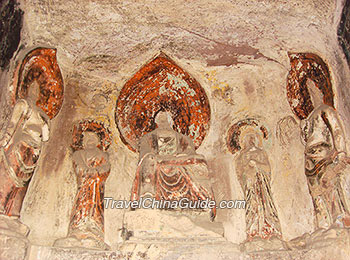 | | Buddha Statues, Great Buddha Temple | |
 Other Scenic Spots
Other Scenic Spots:
Maoling Mausoleum,
Zhaoling Mausoleum,
Xianyang Museum,
Tomb of Crown Prince Yide,
Tomb of Crown Prince Zhanghuai,
Tomb of Huo Qubing,
Tomb of Princess Yongtai,
Sanyuan City God Temple,
Museum Garden of Northwest A & F University,
Yuanjiacun Folk Village 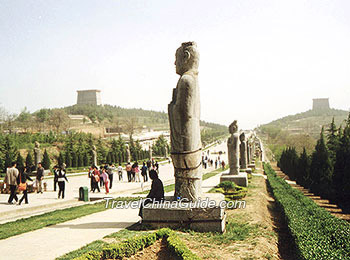 | | Sacred Way, Qianling Mausoleum | | 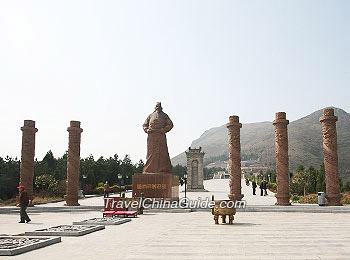 | | Zhaoling Mausoleum | |
How to Get to Xianyang
1. Xi'an Xianyang International Airport is 13 kilometers northeast of downtown area, operating flights to over sixty cities at home and abroad. There are six airport bus lines departing daily from the pick-up points in Xi'an and Xianyang.
2. Visitors can take Bus No.59, which shuttles between them. In addition, the Xianyang Bus Station is on Xilan Lu, in Qindu District, where bus services operate for other cities and counties inside the province. The West Bus Station in Xi'an has buses running to the city departing as soon as the buses are full.
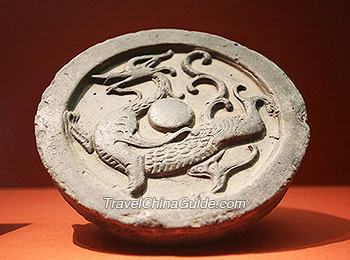 | | Tile of Han Dynasty, Xianyang Museum | | 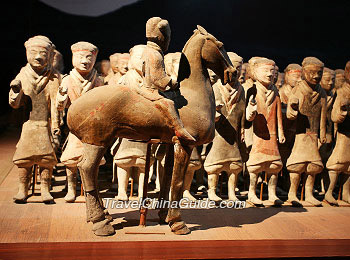 | | Terra-cotta Warriors and Horses, Xianyang Museum | |
Weather
-
The area has a warm temperate continental monsoon climate which features a chilly winter and torrid summer. Overcast and rainy days are most frequent in summer and autumn. Extreme heat may sear the city in summer causing high temperature of Xianyang weather in excess of 40 C (104
C (104 F). Visitors can choose any time to visit the place. However, avoiding the height of summer and the middle of winter is recommended.
F). Visitors can choose any time to visit the place. However, avoiding the height of summer and the middle of winter is recommended.
Xianyang Travel Tips
 History: Xianyang is an ancient capital. The first feudal dynasty in Chinese history, the Qin Dynasty, made it the capital city and planted the seeds of its impressive history. Historically, it once served as the capital for thirteen dynasties, leaving a legacy of twenty-seven tombs of emperors and hundreds of graves of imperial household members.
History: Xianyang is an ancient capital. The first feudal dynasty in Chinese history, the Qin Dynasty, made it the capital city and planted the seeds of its impressive history. Historically, it once served as the capital for thirteen dynasties, leaving a legacy of twenty-seven tombs of emperors and hundreds of graves of imperial household members.

Physical Features:
The northern part of the city is situated on the Loess Plateau, while the south is a part of the Weihe Plain. In general, the terrain gradually falls away from the north to the south. Special Local Products: Xifeng Liquor, Huanggui Thick Wine (Huang Gui Chou Jiu), Amber Candy (Hu Po Tang), and embroidery.
Special Local Products: Xifeng Liquor, Huanggui Thick Wine (Huang Gui Chou Jiu), Amber Candy (Hu Po Tang), and embroidery.
- Last updated on Jul. 22, 2024 by Brenda Lian -
![]() Pictures
Pictures![]() Qian Mausoleum: The mausoleum contains the reposed Emperor Gao Zong of Tang Dynasty (618-907) and his Empress Wu Zetian, the only female monarch in Chinese history. The mausoleum is built against the backdrop of Liangshan Hill, and the tomb design replicates the ancient Chang'an city.
Qian Mausoleum: The mausoleum contains the reposed Emperor Gao Zong of Tang Dynasty (618-907) and his Empress Wu Zetian, the only female monarch in Chinese history. The mausoleum is built against the backdrop of Liangshan Hill, and the tomb design replicates the ancient Chang'an city.![]() Great Buddha Temple (Da Fo Si): 10 kilometers west of Binxian County, this Buddhist site has stood for over 1,300 years. A total of 130 grottoes on the 400-meter-long rock surface store thousands of Buddha statues of all sizes. Within the temple, the 20-meter-tall Buddha is the most spectacular one.
Great Buddha Temple (Da Fo Si): 10 kilometers west of Binxian County, this Buddhist site has stood for over 1,300 years. A total of 130 grottoes on the 400-meter-long rock surface store thousands of Buddha statues of all sizes. Within the temple, the 20-meter-tall Buddha is the most spectacular one.![]() C (104
C (104![]() F). Visitors can choose any time to visit the place. However, avoiding the height of summer and the middle of winter is recommended.
F). Visitors can choose any time to visit the place. However, avoiding the height of summer and the middle of winter is recommended.![]() History: Xianyang is an ancient capital. The first feudal dynasty in Chinese history, the Qin Dynasty, made it the capital city and planted the seeds of its impressive history. Historically, it once served as the capital for thirteen dynasties, leaving a legacy of twenty-seven tombs of emperors and hundreds of graves of imperial household members.
History: Xianyang is an ancient capital. The first feudal dynasty in Chinese history, the Qin Dynasty, made it the capital city and planted the seeds of its impressive history. Historically, it once served as the capital for thirteen dynasties, leaving a legacy of twenty-seven tombs of emperors and hundreds of graves of imperial household members.




